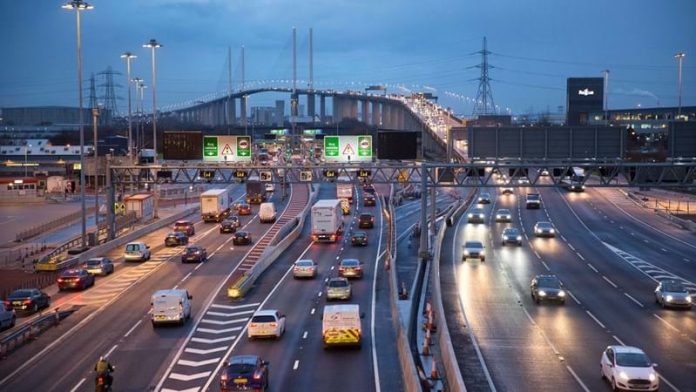The traffic of goods and food across Dartford Crossing has hit record levels after new data shows that traffic itself has increased 9% since the pandemic.
The new figures show that despite the unprecedented restrictions last year in England, the crossing consistently carried more traffic than it was supposed to and now carries more food and goods than ever before.
Highways England says the numbers released this week underscore the critical role of the intersection and advocate a planned new Lower Thames crossing “stronger than ever”.
The data shows that during the first national lockdown, which went into effect in March 2020, traffic fell by up to 62.5% to 68,288 in April last year, compared to 182,658 on the corresponding day 12 months earlier.
Motorways England
Dartford Crossing’s crucial role in moving goods and people to key betweek centers, hubs and ports during and after the height of the Covid-19 pandemic has been revealed in new data released today by Highways England.
Built nearly 60 years ago, Dartford Crossing has a total capacity of 135,000 vehicles per day, but it’s currently well above that, hauling more than 180,000 on its busiest days.
The new traffic data shows that while measures to deal with the Covid-19 pandemic have had a dramatic impact on traffic across the UK, traffic has quickly returned to levels last seen before the pandemic.
Trucks passing the transition continued to play an important role in transporting essential goods to supermarkets and homes, with 42% of the vehicles using the now crossing freight vehicles.
The intersection saw its busiest day for trucking traffic in December 2020, and Dartford Crossing traffic data also showed:
- Dartford Crossing traffic has now returned to levels last seen before the pandemic as traffic flows have quickly returned to overcapacity.
- After the first national lockdown in March 2020, traffic on Dartford Crossing dropped dramatically by 62.5%, from 182,658 in April 2019 to 68,288 on the corresponding day in 2020, but for most of 2020 the intersection was in accordance or over their design operated capacity
- December 2020 was the busiest day ever recorded for truck traffic, which is now consistently above the 2019 level.
- before the lockdown, around 33% of vehicles at the intersection were carrying goods; the number is now about 42%
- The busiest day of the crossing ever recorded was Tuesday February 20, 2018 with a massive 206,713 vehicles
Matt Palmer, Executive Director of Lower Thames Crossing, said, “The Covid-19 pandemic has profoundly affected every part of our daily lives, including when and how we travel.
During the pandemic, the Dartford Crossing has played and continues to play a vital role in almost everything we do, from getting essential goods on our shelves and on our doorsteps to visiting friends and family or commuting.
“These numbers show that the Lower Thames Crossing is stronger than ever. While the changes resulting from the pandemic have had a dramatic impact on traffic, they have not affected the Dartford strategic crossing. This only highlights the importance of the Thames crossing is.” to our way of life. ”
 Motorways England
Motorways England
“But despite improvements and 24-hour surveillance, the Dartford Crossing is still above design capacity, which inevitably leads to congestion and delays. The Lower Thames Crossing would almost double the road capacity across the Thames east of London and provide a reliable link. which will add billions. ” to the economy.
“But it also plays a more immediate role in the economic recovery from Covid-19, creating tens of thousands of jobs and hundreds of opportunities for local people and businesses to build.”
This update comes as a new survey found that nearly nine out of ten Dart Charge business account holders would support the proposed Lower Thames Crossing, which would ease traffic jams and improve air quality by diverting over 13 million vehicles away from Dartford each year.
Dave Lilly, owner of Lilly Transport, said, “We lose up to 20 hours a week for each vehicle due to traffic jams.
Highways England is in the midst of a July 14th-September 8th community impact consultation for the Lower Thames Crossing ahead of a development consent request later this year.
If the green light is given, construction is expected to begin in 2024 and take around six years, with the target opening date between 2029 and 2030.
Full details of the advice can be found on the advice website.

